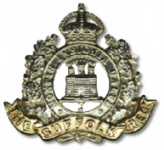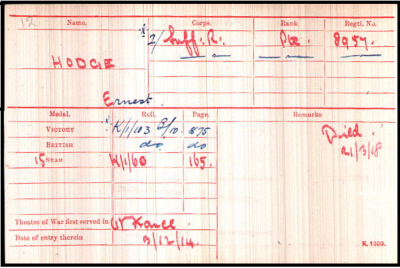



No.8957, Private, Ernest HODGE
Aged 21

|
Ernest Hodge was born in Fordham in 1896, (Newmarket Q3-1896 3B:535), the son of George and Sarah M. HODGE (née SARGEANT).
1901 census...Aged 5, he was at Church Street, Fordham with his father George HODGE [43] Great Eastern Railway porter, born Bluntisham; his mother Sarah Matilda [40] born Fordham; sisters Matilda Florrie [10] and Fanny [6] both born in Newmarket,and Emily [1] born in Fordham, and brothers William Henry [8] born in Newmarket and James [3] born in Fordham. 1911 census...Aged 14, a farm labourer, he was at Church Street with his parents (father now a farm labourer) brother James (farm labourer) sister Emily and sisters Nellie [8] and Hannah [5] both born in Fordham. The family later moved to Carter Street, Fordham. |

|
He enlisted in Bury St. Edmunds.
Early in the war the recruiting campaign was so successful that the facilities at Bury St Edmunds could not cope, so a camp was set up in Cambridge. This catered for those volunteers from the Fens and quickly became known as the "Cambridgeshires" despite there being an actual Cambridgeshire Regiment. This was quickly rectified by instituting the 11th Battalion, Suffolk Regiment. 21st March 1918 was the opening day of the Kaiserschlacht, the German Spring Offensive which came so close to defeating the Allies. Using storm troops the Germans made great advances before being held long enough for Allied reserves to be brought forward, reserves being something the Germans no longer had. The 11th Suffolks were in the Sensee valley and by nightfall on the 21st the Germans had broken through to St Leger. The enemy continued to advance and the battalion were ordered to withdraw from Croiselle front line which had been the old Hindenburg support line. The battalion received orders to retire to a second position with an outpost line abreast of Croiselles and the withdrawal began about 8:30 that night. The engineers saturating the woodwork of their tunnel in the old Hindenburg line with petrol and firing it. All through the night they were subjected to the heaviest and most concentrated bombardment they had ever experienced. Remarkably the battalion only had 12 killed, but 50 more died the following day.  photo: Commonwealth War Graves Commission click here to go to the Commonwealth War Graves Commission website for full cemetery/memorial details |